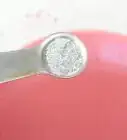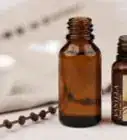wikiHow is a “wiki,” similar to Wikipedia, which means that many of our articles are co-written by multiple authors. To create this article, 95 people, some anonymous, worked to edit and improve it over time.
wikiHow marks an article as reader-approved once it receives enough positive feedback. This article received 56 testimonials and 95% of readers who voted found it helpful, earning it our reader-approved status.
This article has been viewed 1,604,671 times.
Learn more...
Do you want to make your own signature scent? Or maybe you’re looking for a unique homemade gift idea. You can make your very own exciting scents with ingredients from the grocery store.
Steps
Understanding the Science of Perfume
-
1Know the different notes. Perfumes are a blend of different levels of scent, also called “notes”. When you spray a fragrance on your skin, it moves through these notes in the following order:
- Top notes are what you smell first. They are also what disappears first, usually within 10 to 15 minutes.
- Middle notes appear as the top notes die off. These are the fragrance’s core, determining which family the perfume belongs to — for example, oriental, woody, fresh, or floral.
- Base notes accentuate and fix the fragrance’s middle notes, also known as its theme. They comprise the fragrance’s foundation, making the scent last up to 4 or 5 hours on your skin.
-
2Familiarize yourself with popular top notes. Popular top notes include basil, bergamot, grapefruit, lavender, lemon, lime, mint, neroli, rosemary, and sweet orange.[1]Advertisement
-
3Familiarize yourself with popular middle notes. These include black pepper, cardamom, chamomile, cinnamon, clove, fir needle, jasmine, juniper, lemongrass, neroli, nutmeg, rose, rosewood, and ylang-ylang.[2]
-
4Familiarize yourself with popular base notes. These include cedarwood, cypress, ginger, patchouli, pine, sandalwood, vanilla, and vetiver.[3]
-
5Know the ratios. When mixing a fragrance, first add your base notes, then your middle notes, then finally, your top notes. The ideal ratio for blending notes is 30% top notes, 50% middle notes, and 20% base notes.
- Some perfumers recommend combining a maximum of 3 to 4 dominant notes.
-
6Know the basic recipe. To make a perfume, you need more than just the top, middle, and base notes: you also need something to add them to.
- Your process begins with a carrier oil. Popular choices include jojoba, sweet almond, and grape seed oil.
- Next, you’ll slowly add drops of your base, middle, and top notes to the carrier oil.
- Finally, you’ll add something to help merge the ingredients together. Alcohol is a popular choice because it evaporates quickly and helps diffuse the perfume’s notes. A common choice amongst DIY perfumers is a high-quality, 80- to 100-proof (40% to 50% alc/vol) vodka.
- If you’re looking to make a solid perfume (more like a lip balm), use melted beeswax for the fixative instead of alcohol or water.
-
7Find out what notes your favorite perfumes contain. If you’re unsure of how to structure a perfume, have a look at the ingredients of your favorite commercial scents.
- If you have trouble finding the ingredients or separating them into notes, the Basenotes website is a great resource for breaking down the notes in popular perfumes.[4]
Knowing What Materials You Need
-
1Buy dark glass containers. Many people recommend using dark glass containers because the dark glass helps protect your perfume from light, which can shorten its lifespan.
- You’ll also want to make sure your glass containers haven’t previously contained any food items, as any residual scents will transfer to your perfume.
- The exception to this would be if you actually wanted to use the scent of what was in the glass container before. (Warning: peanut-butter-banana-chocolate perfume might taste better than it smells!)
-
2Buy a carrier oil. A carrier oil is what carries the scents in a particular fragrance on to your skin. These are generally unscented, and are used to dilute concentrated oils and aromatics that can otherwise irritate your skin.
- Your carrier oil can really be anything. You can even use olive oil if you don’t mind the scent.
- One popular perfumer simmers rose petals in virgin olive oil, then combines it all with vitamin E oil to stabilize it.[5]
-
3Buy the strongest alcohol you can find. A common choice amongst many DIY perfumers is a high-quality, 80- to 100-proof (40% to 50% alc/vol) vodka. Other DIY perfumers favour 190-proof (80% alc/vol) alcohol.
- Popular choices for 190-proof alcohol include organic neutral grape alcohol and the much cheaper Everclear, which is a grain spirit.[6]
-
4Select your scents. Your perfume can be made out of a wide variety of ingredients. Common aromatics for perfumes include essential oils, flower petals, leaves, and herbs.
-
5Decide on a method. The method for making perfume will vary slightly depending on your materials. Two common aromatics used for perfume are plant materials (flowers, leaves, and herbs) and essential oils; the methods vary for each of these.
Using Fresh Flowers, Leaves or Herbs
-
1Obtain a clean glass container. The type of container isn’t as important as the material: just make sure that a) it’s clean and b) it’s glass. The container also needs to have a tight-fitting lid.But having dark containers also helps for preserving.
- Perfumers generally recommend using dark glass, which can lengthen the fragrance’s life by protecting it from light.
- Avoid using jars that have previously contained food items, even if they’ve been washed out, as the glass might pass the scent on.
-
2Obtain an odorless oil. Popular choices for use in perfumes include jojoba oil, almond oil, and grape seed oil.
-
3Collect flowers, leaves, or herbs whose scent appeals to you. Be sure to collect plant materials when the scent is strong and the leaves are dry. Letting them air out can leave them limp and with a less effective scent.[7]
- You may want to collect and dry more plants than you need, just in case you want to add more to strengthen the oil’s scent later on.
-
4Remove any unwanted plant materials. If you’re using flowers, use only the petals. If you’re using leaves or herbs, remove any twigs or other bits that might interfere with the scent.
-
5Bruise the plant materials lightly. This step is optional, but may help to bring out the scent more. You’ll just want to lightly press on the plant materials with a wooden spoon.
-
6Pour some oil into the glass container. It need only be a small amount — just enough to properly coat and cover your petals/leaves/herbs.
-
7Add the plant materials to the oil and shut the lid. Ensure that the lid is closed tightly.
-
8Let the jar sit in a cool, dark place for one to two weeks.
-
9Open, strain and repeat. If the oil doesn’t smell as strong as you’d like it to after one to two weeks, you can strain out the old plant materials and add new ones to the scented oil, then store it once more.
- You can repeat this process for several weeks or even months until the oil has reached the desired strength.
- Be sure to keep the oil! It’s the old plant materials that you want to discard.
-
10Preserve your scented oil. Once you’re happy with the oil, you can add 1 or 2 drops of a natural preservative such as vitamin E or grapefruit seed extract to your scented oil to help extend its life.[8]
- If you’d like to turn the oil into a balm, you can also add some beeswax to it: melt some beeswax in the microwave, combine it with the perfume, then dump the whole mixture into a container to cool and solidify.
Using Essential Oils
-
1Gather your materials. You’ll need the following ingredients:
- 2 tbsp carrier oil (jojoba, almond, or grape seed will do)
- 6 tbsp 100- to 190-proof alcohol
- 2.5 tbsp bottled (not tap) water
- 30 drops of essential oils (at least 1 of each: base, middle, and top)
- Coffee filter
- Funnel
- 2 clean glass containers
-
2Pour 2 tbsp carrier oil into the glass bottle.
-
3Add your essential oils. You’ll want to add roughly 30 drops in total. Start with your base notes, then add your middle notes, then add your top notes. The ideal ratio is 20% base, 50% middle, and 30% top.
- Pay attention to the scents that you are adding: if one scent is much stronger than the rest, you’ll want to add less of it so that it doesn’t overpower everything else.
-
4Add the alcohol. Use a high-quality alcohol with a high alcohol content. Vodka is a popular choice amongst DIY perfumers.
-
5Allow the perfume to sit for at least 48 hours. Shut the lid and allow the perfume to cure for at least 48 hours. You can leave it for up to 6 weeks, which is when its scent will be at its strongest.
- Check the bottle regularly to see where the scent is at.
-
6Add 2 tbsp bottled water. Once you’re happy with the scent, add 2 tbsp bottled water to your perfume.
-
7Shake the bottle vigorously. Do this for 1 minute to ensure that the contents are well blended.
-
8Transfer the perfume to another bottle. Using a coffee filter and a funnel, pour your perfume into a clean, dark glass bottle. You can also transfer it to a fancy bottle if you’re giving it as a gift.
- You may want to label the bottle with the ingredients and a date on it so that you can keep track of how long it lasts. That way, you’ll know whether you should make more or less the next time around.
-
9Try a variation. To make a solid perfume (like a lip balm) instead of a spray/liquid perfume, try substituting the water with melted beeswax. You would add the melted beeswax to your perfume and then pour the warm mixture into a container to solidify.
- You can buy beeswax at most health food stores.
Community Q&A
-
QuestionWhy the coffee filter? If using only oils water and alcohol there shouldn't be any particulate matter.
 Community AnswerThe coffee filter is used because after the sitting process, there develop some minute particles that, when mixed with water, can be seen in a transparent bottle. That's why you need a coffee filter, to prevent any cloudiness.
Community AnswerThe coffee filter is used because after the sitting process, there develop some minute particles that, when mixed with water, can be seen in a transparent bottle. That's why you need a coffee filter, to prevent any cloudiness. -
QuestionHow do I know what date to put on the bottle -- for how long it will last?
 Community AnswerThe date to put on the bottle is when you get the final product completely finished. As for how long it will last, most handmade perfumes should be used within three months, and at the latest, within six months. The amount of time the perfume lasts will be affected by how it is stored, as heat, high levels of humidity and light will cause it to deteriorate much faster than cool, dry and dark storage places.
Community AnswerThe date to put on the bottle is when you get the final product completely finished. As for how long it will last, most handmade perfumes should be used within three months, and at the latest, within six months. The amount of time the perfume lasts will be affected by how it is stored, as heat, high levels of humidity and light will cause it to deteriorate much faster than cool, dry and dark storage places. -
QuestionHow do I open a perfume business?
 Community AnswerStart by sharing your products with family and friends so they can help spread your business through word-of-mouth. Open accounts on social media for your business and create a website to sell your perfume.
Community AnswerStart by sharing your products with family and friends so they can help spread your business through word-of-mouth. Open accounts on social media for your business and create a website to sell your perfume.
Warnings
- Avoid putting fruit juices in your perfume, as they can curdle the perfume or make it go rancid. In addition, lemons are phototoxic, meaning that applying things containing lemon juice to your skin can cause your skin to burn in the sun.⧼thumbs_response⧽
References
- ↑ http://www.aromaweb.com/essentialoils/default.asp
- ↑ http://www.aromaweb.com/essentialoils/default.asp
- ↑ http://www.aromaweb.com/essentialoils/default.asp
- ↑ http://www.basenotes.net
- ↑ http://www.nytimes.com/2010/06/10/garden/10perfume.html?_r=0
- ↑ http://www.nytimes.com/2010/06/10/garden/10perfume.html?_r=0
- ↑ http://www.nytimes.com/2010/06/10/garden/10perfume.html?_r=0
- ↑ https://www.fromnaturewithlove.com/library/preservatives.asp
- Videos provided by Soap Queen TV
About This Article
To make perfume, first pick a "carrier" oil, like jojoba or grape seed. Then add the scents you want, like lavender, jasmine, and vanilla, for example. Be sure to pick a combination of short, medium, and long-lasting scents so your fragrance lasts as you wear it! Next, add alcohol, like vodka, to hold your scents together. Store your perfume in dark glass bottles to preserve your scent over time, and let it sit just a couple of days for a light scent or several weeks for a stronger one. If you want to learn more about how to use fresh flowers or herbs in your perfume, keep reading!


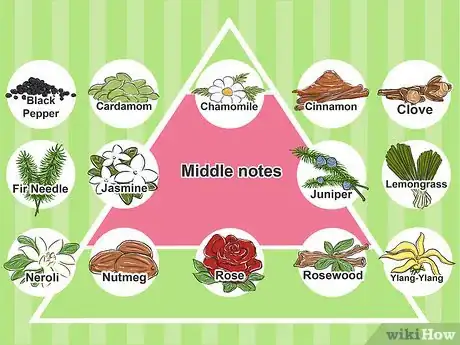
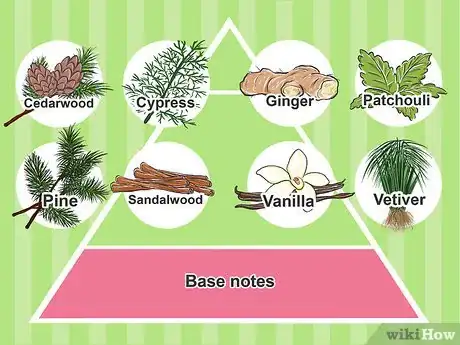
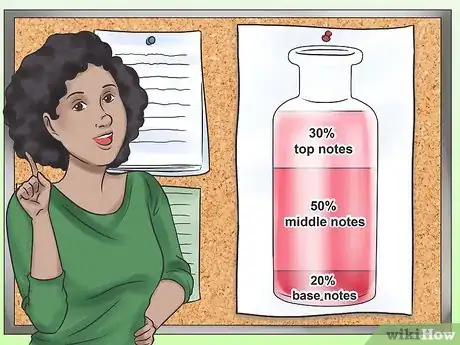
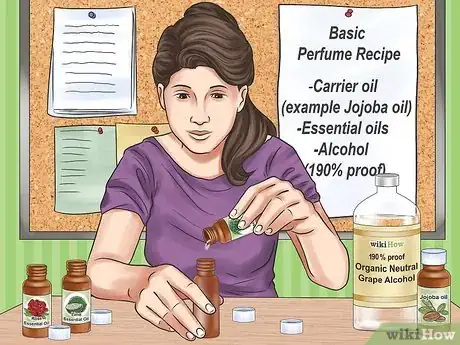
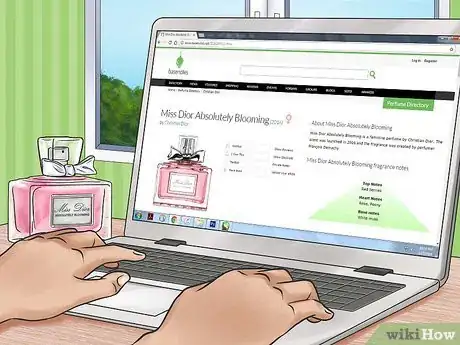

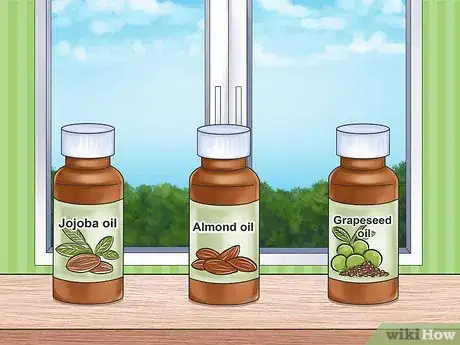
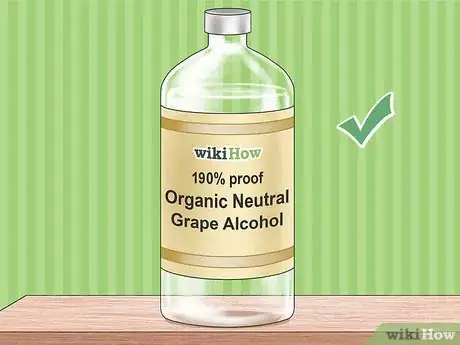


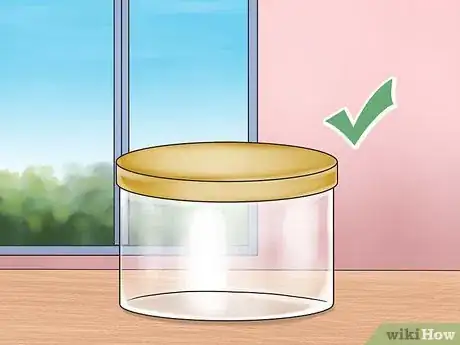
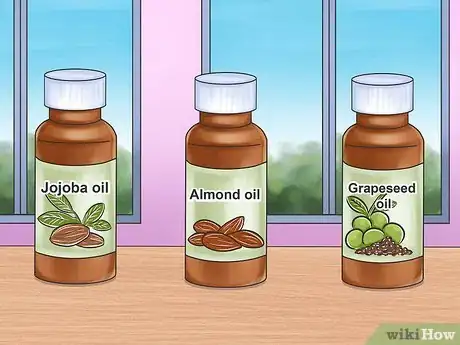
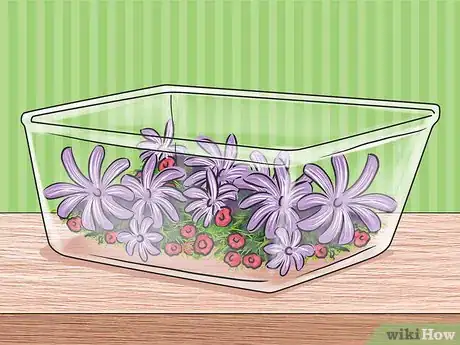
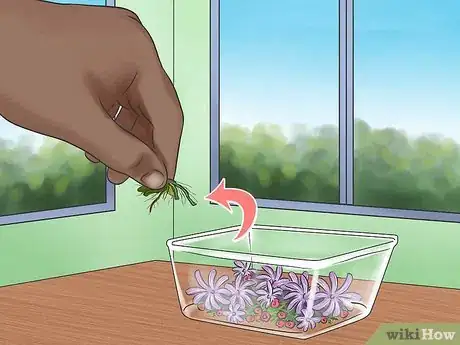

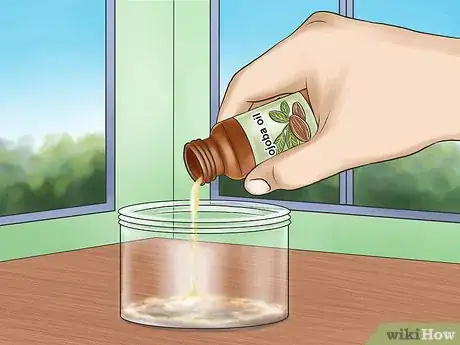
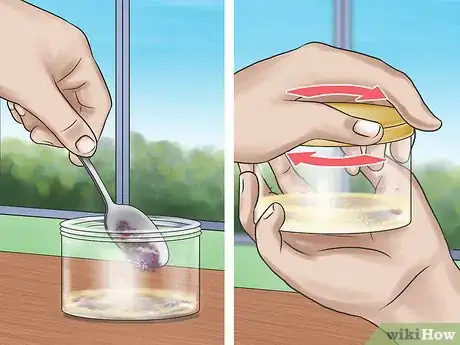


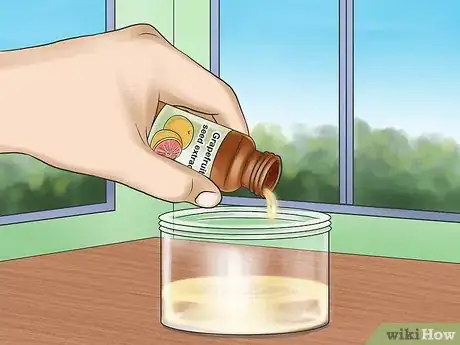
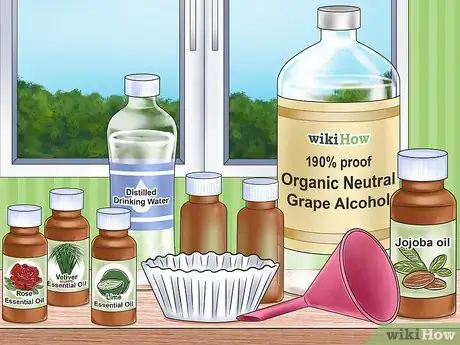



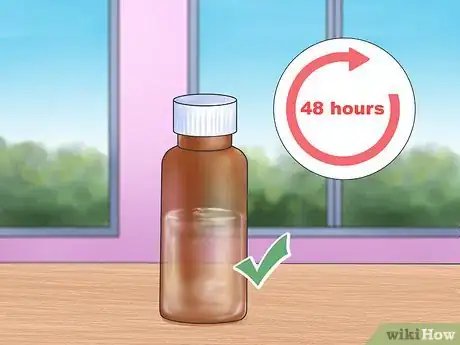
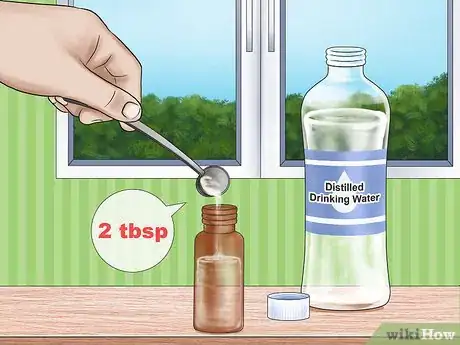

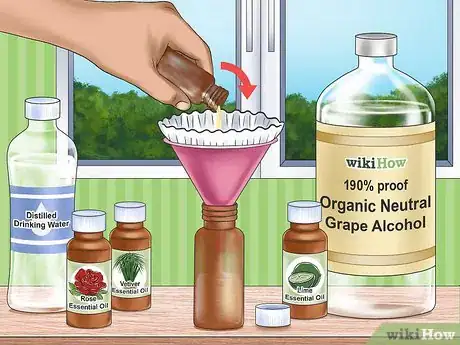
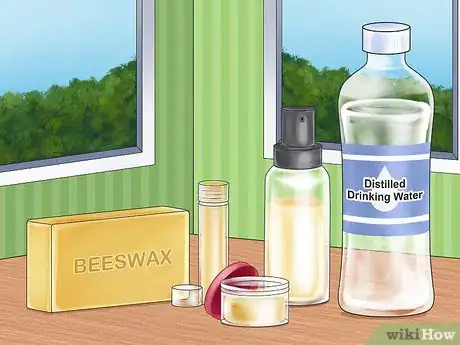
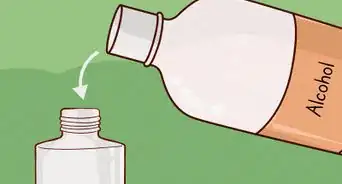

-Step-13.webp)










